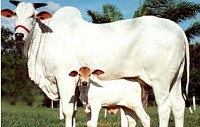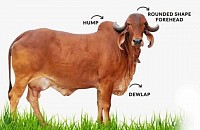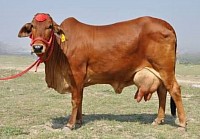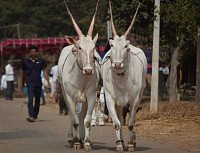Indian Cows
Indian cows are important for their deep religious significance as sacred symbols of life and mother goddesses (Gau Mata) in Hinduism, and for their economic and environmental value as providers of milk, dairy products, fuel (dung), and organic fertilizer, supporting rural livelihoods and sustainable agriculture. Their veneration is also rooted in historical use for agriculture and as a rational survival strategy that evolved into a cultural norm.
Religious and Cultural Importance
Sacred Symbolism: In Hinduism, the cow is considered sacred, embodying divine and natural beneficence. It is revered as a symbol of motherhood, purity, and prosperity.
"Gau Mata": Cows are affectionately called "Gau Mata" (mother cow), symbolizing the earth's capacity to nourish all life.
Deity Associations: Cows are associated with deities like Lord Krishna and the goddess Kamadhenu, a divine wish-granting cow.
Rituals and Festivals: Cows are adorned and worshipped during festivals, such as Gopashtami and Govardhan Puja, to honor their importance.
Economic and Environmental Significance
Nutritional Source: Cows provide milk, a vital source of nutrition and a livelihood for millions of people, as well as products like ghee, yogurt, and paneer.
Organic Farming: Cow dung is a valuable resource used as organic manure to enrich soil fertility and as a natural fuel for cooking and heating.
Rural Economy: The dairy industry centered around cows generates significant employment and income, especially for small-scale farmers in rural areas.
Sustainable Practices: The use of cow dung and urine in farming supports eco-friendly practices, reducing reliance on chemical fertilizers and promoting sustainable agriculture.
Historical Roots
Agricultural Utility: Historically, cows provided draft power for plowing and were essential for agriculture and household survival.
Cultural Evolution: The long-term utility of cows in an agrarian society, especially during hardships, likely contributed to their veneration.
Native Breeds: The adaptability of indigenous Indian Zebu cattle to local conditions further reinforced their importance and value.
Cow Values And Importance in IndiaCow Values And Importance in India
In India, cows hold a special place in the hearts and lives of the people. They are not just animals but are seen as symbols of life and sustenance. Their significance goes beyond their role in agriculture and dairy farming. Let’s explore why cows are so valued in India.
Cultural and Religious Significance
Cows are deeply rooted in Indian culture and religion. In Hinduism, cows are considered sacred and are associated with various deities. For instance, Lord Krishna, one of the most revered gods, is often depicted as a cowherd. Hindus believe that cows are embodiments of divine and natural beneficence. They are honored in many rituals and festivals. One such festival is Gopashtami, which celebrates cows and their importance in the ecosystem.
Agricultural Backbone – Cow Values And Importance in India
In rural India, cows are indispensable to farming. They are used as draft animals, pulling plows and carts, which is crucial for small farmers who cannot afford modern machinery. Cow dung is an excellent natural fertilizer, enriching the soil and promoting sustainable farming practices. This helps in growing healthy crops without the need for chemical fertilizers.
Source of Nutrition
Cows provide milk, a staple in the Indian diet. Milk and milk products like yogurt, butter, and ghee are essential ingredients in daily meals and special dishes. These products are rich in nutrients and are considered beneficial for health. Many families in India rear cows for their milk, which supports their livelihood.
Environmental Benefits
Cow Values And Importance in India – Cows contribute to the environment in multiple ways. Their dung is not only used as fertilizer but also as a fuel source in rural areas. Dried cow dung cakes are used as a natural and cost-effective alternative to firewood and coal. This helps in reducing deforestation and pollution. Moreover, cow dung is used in biogas production, providing a clean and renewable source of energy.
Economic Impact
Cows play a significant role in the rural economy. The sale of milk and dairy products is a major source of income for many families. Additionally, cow by-products like dung and urine are used to produce bio-fertilizers and bio-pesticides, which are in demand among organic farmers. This creates job opportunities and supports the local economy.
Social and Emotional Connection
For many Indians, cows are more than just animals; they are part of the family. They are treated with love and care, and their well-being is a priority. This deep bond is reflected in various traditions and daily practices. For instance, in many households, cows are decorated and worshipped during festivals, and special prayers are offered for their health and prosperity.
Challenges and Future Prospects
Despite their importance, cows in India face several challenges. Stray cattle, inadequate veterinary care, and exploitation in the dairy industry are pressing issues. It is crucial to address these problems to ensure the welfare of cows. Efforts are being made to improve their living conditions through better veterinary services, shelter homes, and awareness programs.
In conclusion, cows are integral to the Indian way of life, symbolizing more than just agricultural utility. They represent cultural heritage, economic stability, and environmental sustainability. By understanding and respecting their value, we can ensure that cows continue to be a cherished part of India’s future.
Across India, sacred cow breeds such as Gir (Gujarat), Sahiwal (Punjab), Ongole (Andhra Pradesh) and Hallikar (Karnataka).
While there is no single cow breed called Kamadhenu, all indigenous Indian breeds are considered part of Kamadhenu's lineage, as she is the "mother of all cows" and a divine symbol of abundance and prosperity. The concept of indigenous breeds like Gir, Sahiwal, Ongole and Hallikar being linked to Kamadhenu is tied to the reverence for the cow in Hinduism and the belief that these breeds embody divine energy and provide practical agricultural benefits. Why Indian Cows Are Linked to Kamadhenu Surabhi: Kamadhenu is also known as Surabhi, a divine bovine goddess who emerged from the churning of the Milky Ocean.
"Mother of All Cows": As the mother of all cows, all earthly cows are believed to be her earthly embodiment and part of her divine lineage.
Indigenous Breeds: Specific breeds such as Gir, Sahiwal, Ongole, and Hallikar are revered because they are seen as carrying both divine energy and offering practical agricultural benefits.
Sacred Cow Gomata: In Hinduism, the cow, or gomata, is a sacred symbol, and by extension, Kamadhenu is a powerful symbol of abundance, purity, and prosperity. Examples of Indian Cow Breeds that is considered part of Kamadhenu's lineage carrying both divine energy and practical agricultural benefits
Ongole Cows
The Ongole cow, also known as Ongole Gitta, is a large, powerful indigenous breed from the Prakasam district of Andhra Pradesh, India, recognized for its strength, heat resistance, majestic white coat, and suitability as a triple-purpose animal for milk, meat, and draught work. Key features include a broad, flat forehead, muscular body, prominent hump in males, large fan-shaped dewlap, and short, stumpy horns. These hardy, docile animals are adaptable to harsh conditions and perform well in tropical environments, making them a valuable resource for cattle production. Origin and Habitat Origin: Native to the Ongole taluk in the Prakasam district of AndhraPradesh,
India.Breeding Tract: Includes regions of Andhra Pradesh such as East Godavari, Guntur, Ongole, Nellore, and Kurnool districts.
Physical Characteristics Coat: A glossy, predominantly white or light grey coat, sometimes referred to as padakateeru.
Body: Large, muscular, and powerfully built with excellent draught qualities.
Hump: Well-developed and erect in males, filled on both sides.
Horns: Short and stumpy.
Any Location, any Temperature conditions sutible, and also agriculture purpose, any desises can control, and it's god vahanamau vehicle and security, etc...
Dewlap: Large, fan-shaped, and fleshy.
Markings: Males often have dark markings on the head, neck, and hump, as well as black on the knees and pasterns.
Uses and Adaptability Triple-Purpose
Breed: Serves as a strong draught animal, a source of agriculture and a producer of milk.
Draught Power: Renowned for its steady, heavy draught capabilities, making it suitable for agricultural work.
Hardiness: Highly resistant to diseases and capable of thriving in difficult conditions with limited resources. Tropical Adaptation: Its traits and productive capacity make it a sought-after breed in tropical cattle production.
Temperament Docile: The breed is known for being extremely docile.
The importance of the Ongole cow lies in its unique combination of hardiness, disease resistance, and adaptability to tropical climates, making it a valuable triple-purpose breed for milk, draught work. Renowned for its strength, majestic size, and the presence of A2 milk protein, the Ongole breed is a crucial genetic resource for agricultural development, particularly in tropical regions, and was the first Indian cattle breed to gain worldwide recognition.
There isn't a specific "god" for Ongole cows, but there are religious customs related to them, such as dedicating superior stud bulls to local deities as a community effort for livestock improvement, a practice with social, religious, and economic functions in Hindu traditions. The cow itself is considered a divine abode in Hinduism, symbolizing interconnectedness of life.
Religious Customs
Vahana (Vehicle): In Hinduism, the cow is considered a vahana (mount) for certain deities, such as Dattatreya and Umiya Maa.
Deity Association: The cow's presence is linked to the divine, with different deities believed to reside on various parts of the cow's body.
Community Practice: In the Ongole region, a custom involved dedicating the best young bull to the local deity as a community offering. This bull would be set free to sire the village herd.
Cultural Significance
Sacredness of the Cow: The cow holds significant religious and cultural importance in India, seen as a symbol of abundance, motherhood, and life itself.
Connection to Deities: Lord Krishna and his Yadava kinsmen are associated with cows, adding to their revered status.
The Ongole breed is an indigenous cattle breed from Andhra Pradesh, India, known for its strength and adaptability, thriving in various environmental conditions.
Gir Cows
The Gir cow, named after the Gir forest in Gujarat, India, is a renowned indigenous dairy breed known for its high milk yield and rich A2 milk. Key features include its distinctive dome-shaped forehead, long, pendulous ears, and red to white spotted coat. Gir cows are highly adaptable to tropical climates, possess strong disease resistance, and are valued for their longevity and easy maintenance. The breed's milk is rich in fat and protein, contributing to the production of quality ghee and other dairy products.
Key Characteristics
Origin: The Gir forest in the Saurashtra region of Gujarat, India.
Appearance:
Color: Red to spotted white, though colors can vary.
Forehead: Prominent, dome-shaped, and often described as a "bony shield".
Ears: Long, pendulous, and folded like a leaf with a knot at the tip.
Hump: A large, prominent hump that differentiates it from other breeds.
Milk: Produces A2 milk, which is rich in butterfat, making it ideal for high-quality ghee and other dairy products.
Temperament: Known for being humble, polite, and calm.
Advantages & Benefits
High Milk Production: Gir cows are excellent milkers, with an average milk yield around 2,110 kg per lactation.
Adaptability: The breed is well-suited to tropical climates and is resistant to heat stress and various tropical diseases.
Disease Resistance: Possesses a strong immune system, making it less prone to diseases and health issues.
Longevity & Fertility: Known for good fertility and a long productive lifespan.
Economic Value: Its high-quality milk and adaptability make it a valuable asset for the dairy industry.
Cultural & Environmental Significance: The breed holds cultural significance and is promoted for sustainable agriculture and rural development.
Sahiwal Cows
Sahiwal cows are a Zebu dairy breed known for high milk production, high butterfat content, and excellent heat and disease resistance, making them ideal for dairy farming in warm climates. These medium-sized, sturdy cattle are typically reddish-brown with a large hump in males and have well-developed udders. They originated in the Punjab region of India and Pakistan and are exported globally for their resilience and productivity.
Physical Characteristics
Color: Primarily reddish-brown to light brown, though they can have white markings.
Size: Medium to large frame, with cows weighing around 400-600 kg and bulls weighing more.
Hump: Large and massive in males, often leaning to one side, while in females it's nominal.
Other Features: They have drooping ears, short to medium horns, a long naval flap, and loose, fine skin with a voluminous dewlap.
Udder: Well-developed with long teats, facilitating easy milking.
Milk Production & Quality
Average Yield: Cows produce 2,000 to 3,000 kg of milk per lactation cycle.
Butterfat: Milk is rich in butterfat, averaging 4.5% to 5.5%.
Productivity: Known for high milk yield and efficient milk production, especially with good feed management.
Origin & Temperament
Origin: The breed originated in the Sindh province of Pakistan and central Punjab, India.
Temperament: They are known for their docile and robust temperament.
Adaptability & Health
Heat Tolerance: Highly adapted to hot, dry climates due to their heat-resistant skin.
Disease Resistance: Possess high immunity to common diseases.
Longevity: They have good herd life and productive life, with frequent calving.
Uses & Importance
Dairy Farming: An excellent choice for commercial dairy farming due to high milk quality and consistent productivity.
Global Distribution: Exported to various countries in Africa, Asia, and the Americas for their desirable traits.
Hallikar Cows
Hallikar cows are a native draught (work) breed from Karnataka, India, known for their strength, endurance, and trotting ability, making them ideal for agricultural work and transport. They are medium-sized with a compact, muscular build, a prominent forehead, and long, backward-curving horns. Their coat is typically white to light grey, though variations exist, and males have a well-developed hump. While they are poor milk producers, their milk is nutritious and can be used to make clarified butter.
Origin and Habitat
Origin: The breed originates from the former princely state of Vijayanagar, primarily in the southern districts of Karnataka, including Mysore, Mandya, and Tumkur.
Habitat: They are found in the traditional "Hallikar belt" of South Karnataka, including the districts of Mysore, Mandya, Kolar, Hassan, and Bangalore.
Physical Characteristics
Size and Build: Medium-sized with a compact, muscular body and strong legs.
Color: Typically white to light grey, but can range to grey-black.
Horns: Long, prominent, and backward-curving, with pointed tips.
Head: Features a long, tapering muzzle and a prominent forehead.
Hump: Males possess a well-developed hump.
Utility and Performance
Draught Power: They are considered one of the best draught breeds in Southern India, known for their endurance and power in pulling carts.
Trotting Ability: Especially valued for their ability to cover long distances quickly while pulling loads.
Milk Production: Hallikar cows are not significant dairy animals, yielding around 542 kg of milk per lactation with a fat content of about 5.7%.
Temperament: They are known for being hardy, intelligent, and energetic, requiring expert handling.
Cultural Significance and Other Uses
Cultural Importance: The breed is named after the Hallikar community, who have a long tradition of cattle rearing.
Progenitor Breed: They are considered the progenitor of other South Indian draught breeds, such as the Amrit Mahal breed.
Products: Their nutritious milk is used to make clarified butter (ghee).




